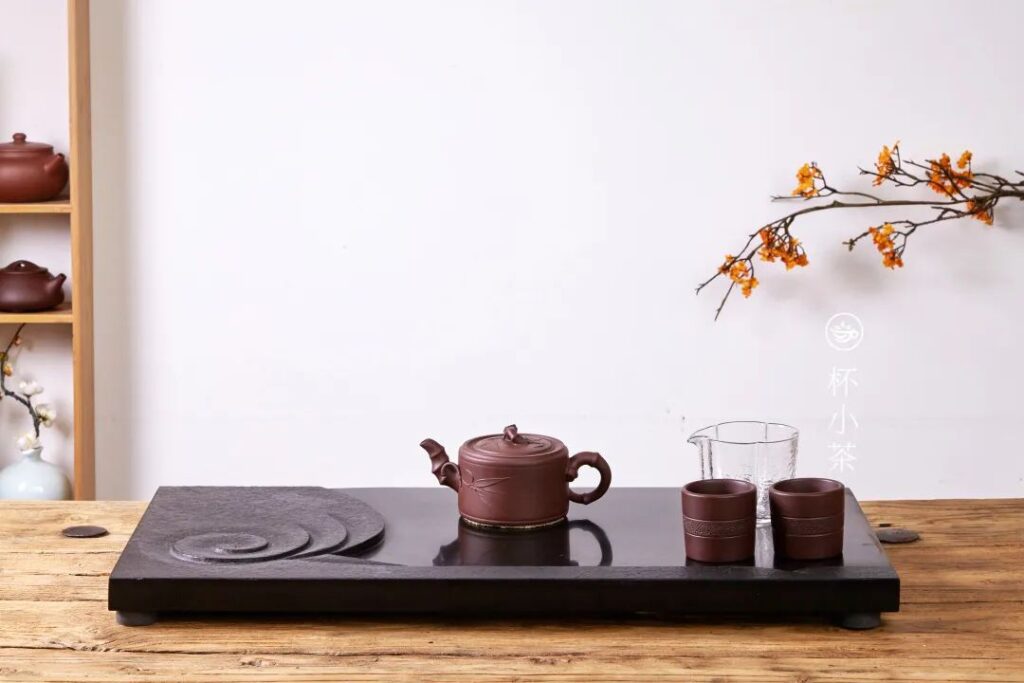Surrounding the use, brewing, serving, and of tasting tea, there is a diverse array of teaware. For instance, a complete set of traditional Gongfu tea utensils requires over ten different items. However, for the average tea lover, mastering the use of a few main teaware pieces is sufficient to brew a good cup of tea.
1. Teapot: The teapot is undoubtedly the protagonist on the tea table. There are various types of teapots, such as Zisha pots, porcelain pots, and glass pots, each with its strengths. Zisha pots perfectly preserve the color, aroma, and taste of tea, often used for brewing Oolong or Pu-erh tea. Smaller Zisha pots are commonly used for brewing Gongfu tea, which is Oolong tea; Zisha pots for brewing Pu-erh tea are generally larger.
After pouring the tea soup into the fair cup, wait for a few seconds to let the tea soup settle, then distribute the tea from the fair cup into the tea cups in a sequence from left to right, and then from right to left. This ensures that the concentration of tea in each cup is essentially consistent. Fair cups come in porcelain, purple sand, and glass textures, with porcelain and glass being the most commonly used.
Some fair cups have handles, while others do not, and there are also fair cups with a filtering mesh, though they are relatively rare. In the process of tea art or Gongfu tea, the fair cup, tea cups, and teapot are the three main characters, so when choosing a fair cup, it is important to ensure it matches with the teapot and tea cups. Generally, the fair cup should be slightly larger than the teapot and lid bowl. A boiling water device can heat boiling water at any time to ensure the taste of the tea soup or to boil tea. Many teas require water at a higher temperature for brewing, and even green teas, which have less stringent temperature requirements, need to control the temperature well, which traditional thermos bottles or boiling water tools cannot easily meet. In ancient times, boiling water for Gongfu tea was done using wind stoves or charcoal stoves, but now we use electromagnetic boiling water devices for greater convenience. The pots used for boiling water include stainless steel pots, clay pots, and high-temperature resistant glass pots. Of course, if you prefer the feeling of a charcoal stove, remember to open the windows and maintain indoor ventilation when using it. Beginners are advised to use electromagnetic heat sources for easy brewing, which is simple, convenient, and safe. For brewing tea while traveling or outdoors, a charcoal stove can be used in combination with a clay pot or iron pot. 6. Tea Tray – If brewing tea is a wonderful performance, our attention is often focused on the actors’ performances, with teapots, tea cups, lid bowls, and other ‘stars’ taking the stage. However, do not overlook the ‘background’ of the stage – the tea tray. The tea tray is a shallow-bottomed vessel for placing teapots, tea cups, tea sets, tea pets, and tea snacks. Its function is, first, to regulate the tea utensils and, second, to catch any spilled tea soup or leaves. Tea trays are mainly made of bamboo and wood, but there are also other materials such as metal, stone, and jade. There are also other shapes, which are less common and have a stronger ornamental value. Regardless of the style of the tea tray, as long as you grasp three points when choosing: wide, flat, and shallow, you won’t go wrong. A wide tray surface allows for more cups when there are many guests; a flat bottom keeps the tea cups stable and less likely to wobble; and a shallow edge can set off the tea cups and teapot, making the overall appearance more aesthetically pleasing. Generally, tea trays are not used for home brewing or dry brewing methods, but are used for wet brewing. The tea ceremonies we see are mostly performed using tea trays. ‘Dry brewing method’ and ‘wet brewing method’ – The dry brewing method generally does not use a tea tray, and discarded tea water is poured directly into the trash can, which keeps the table clean and easy to tidy up, allowing for brewing tea anytime, anywhere.The wet brewing method refers to the practice of freely cleaning tea utensils and rinsing tea on the tea table, with the discarded water being directly poured onto the tea table. The most obvious difference between the two brewing methods is whether a tea tray is used, or if water can be poured directly onto the tabletop.



